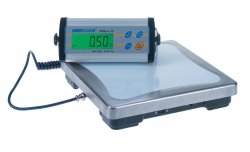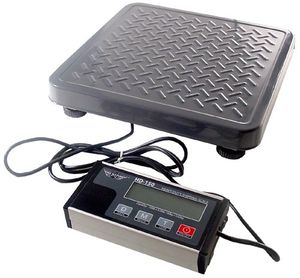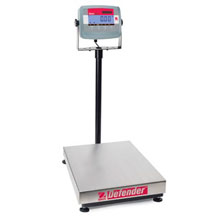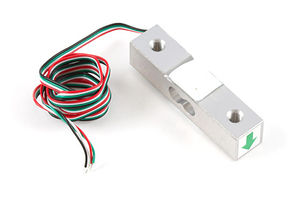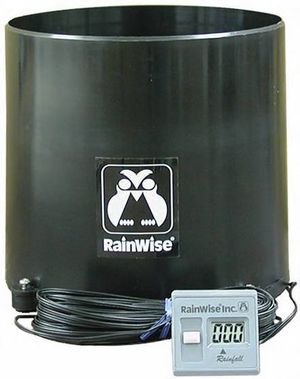Difference between revisions of "Hardware"
(→Do It Yoursel) |
(→Do It Yoursel) |
||
| Line 74: | Line 74: | ||
==== Do It Yoursel==== | ==== Do It Yoursel==== | ||
| − | |||
| − | |||
| − | |||
| − | |||
<table align=right><tr><td> | <table align=right><tr><td> | ||
| − | [[File:Phidgets | + | [[File:Phidgets 3135 0.jpg|thumb|right|x200px|3135_0 - Micro Load Cell (0-50kg) - CZL635]] |
</td><td> | </td><td> | ||
| − | [[File:Phidgets | + | [[File:Phidgets 1046 0 Web.jpg|thumb|x200px|Phidgets PhidgetBridge 4 Wheatstone bridge inputs]] |
</td></tr></table> | </td></tr></table> | ||
| + | |||
| + | Inexpensive load cells similar to the ones used in the Adam Equipment CPWplus200 are available. The signal from the load cells must be amplified and converted to a digital signal using something like the [[http://www.phidgets.com/products.php?category=34&product_id=1046_0 |Phidgets PhidgetBridge]] 4 Wheatstone bridge inputs. | ||
| − | |||
| − | |||
| − | |||
| − | |||
<br clear=all> | <br clear=all> | ||
Revision as of 02:23, 28 January 2014
A scale hive (or bioserver) consists of a computer (desktop, laptop, router, SBC/SOC such as Raspberry Pi), which is used to record, display, and analyze data from sensors such as scales, thermometers, hygrometer, microphone, video camera. As many different brands of hardware as possible are supported, to avoid being locked into one vendor, technology or computing platform as technology advances so rapidly. Listed below are readily available, commercial, off the shelf products that are currently in use or undergoing development and testing.
For an example of how these part can be used, see the Instruction Manual for the Model A.
Computers
Three computer platforms are currently in use:
- Cisco Linksys WRT160NL Router
- Standard x86 based desktop computer
- RaspberryPi
Cisco Linksys WRT160NL wireless router
The Cisco Linksys WRT160NL wireless router contains a 260mhz mips processor, 8 meg of flash, 32 meg of ram, wifi and USB 2.0. The Linux-based open source Wireless-N Broadband Router with Storage Link was created specially for hobbyists and wireless aficionados. The external antennas give users the option of attaching high-gain antennas to improve the wireless range and receive sensitivity of the router. Advantages include low cost, small size, battery operation.
x86 Desktop Computer
Use of a standard desktop computer motherboard allows many instruments to be simply plugged in.
This computer is an old desktop salvaged from a dumpster. It only has 256 Meg RAM. The motherboard, power supply and hard drive were removed from the case and installed in a wooden box the size of a deep super. Since it's based on an inexpensive (or obsolete) standard PC mother board and hard drive, a wide collection of sensors and interface cards are available - most simply plug in.
The PC does require AC power, and won't meet the needs of remote data loggers. But not every apiary needs a scale hive, nor every scale hive need be in an apiary. Plentiful, low cost hardware, vast amounts of quality, open source software, ease of programming and remote administration all lead to rapid development and prototyping and suggest using PC technology, at least as a proof of concept development platform.
The two DMMs used for temperature measurements can be seen on the left side of the box. To the right of the box is the scale that gets placed on top of the computer mother board.
RaspberryPi
RaspberryPi Model B $35 Thanks to Scott, hive GA006 is running the Raspberry Pi. To view it's performance, go back to the main page, click on GA006 and then click on Server Status under Additional Links. The Raspberry Pi is a credit card size ARM processor based complete system that comes loaded with Debian linux. Awesome! Thanks, Scott!
Sensors
When monitoring a hive, the most important variable is weight. While it doesn't tell everything, and can fool you, it does a pretty good job of showing bee activity: foraging, orientation flight, nectar and pollen flows.
Other sensors, such as outside temperature, help explain the weight data. Why did they forage yesterday and not today? The answer may be in the temperature data - because it never got above 50 today.
Inside hive temperature can also provide another piece of the puzzle.
Finally, when trying to figure out some mystery weight curves, a bee counter is essential.
Scales
A word about scales. Also see Tips: Scale Communication for troubleshooting. Three scales are currently in use or are being evaluated
- Adam Equipment CPWplus200
- My Weigh HD300
- Ohaus Defender 3000 with D60 Base
Adam Equipment CPWplus200
The CPWplus200, made by Adam Equipment, has a 440 lb. capacity, 0.1 lb resolution and a RS-232 communication port. The platform size is 12"x12". The scale will run off batteries or an AC power transformer and will automatically switch to battery if the power fails. It is available from American Weigh Scales for $161.25. This scale has proven to be very stable both in long term drift or changes due to operating temperature.
My Weigh HD300
The My Weigh HD300 is available from Canadian Weigh.
There is a problem switching over to battery when AC voltage fails.
warning There is a problem switching over to battery when AC voltage fails.
Ohaus
This Ohaus scale has .02 lb resolution. It is typical of a scale that might be found in a high school or college lab.
Do It Yoursel
Inexpensive load cells similar to the ones used in the Adam Equipment CPWplus200 are available. The signal from the load cells must be amplified and converted to a digital signal using something like the [|Phidgets PhidgetBridge] 4 Wheatstone bridge inputs.
Thermometers
Digital thermometers are used to record ambient and hive temperature. Four digital thermometers are in use
- 1-Wire
- TEMPer USB sticks
- Digital Multi-Meters
- Vernier Corp's Universal Laboratory Interface (ULI)
1-Wire sensors are particularly well suited for placing many sensors in a hive or measuring many hives.<ref>Guidelines for Reliable Long Line 1-Wire Networks http://www.maximintegrated.com/app-notes/index.mvp/id/148</ref> Each 1-wire sensor is uniquely numbered with a 64 bit number. The sensors are ususally wired with a RJ-11 or mini stereo audio connector and plug into the bus controller.
This USB adapter and probes are made by RDing and sold by PCSensor.com hive limited accuracy (only +/- 2 degrees C),
The TEMPer and TEMPer2 USB sticks are made by RDing and sold by PCSensor.com
The TP4000Z is an inexpensive ($29.99) Digital Multi-Meters (DMM) with a temperature probe and RS-232 output. There are two "gotchas" that must be overcome: a 15 minute timeout that turns the meter off to save batteries, and no provision for an external AC power supply. The accuracy of the temperature readings (+/- 3 degrees C) leaves a lot to be desired.
The Universal Lab Interface (ULI) was sold by Vernier Software and Technology for use in high school and college science labs. These are available new and used on e-bay for $25 to $170.
The ULI is a 12 channel 12 bit analog to digital converter. It accepts up to four analog sensors.
A wide variety sensors of sensors are still available from Vernier.
Hygrometers
Digital hygrometers are used to record hive humidity. One hygrometer is currently in use or is being evaluated: 1. TEMPerHUM USB stick
The TEMPerHUM
Raingauge
http://www.rainmanweather.com/site/products/RAINEW-111-Wired-Rain-Gauge
According to the manufacturer, this 8" diameter collector meets NWS specifications for statistical accuracy.
Any tipping bucket type rain gauge should work.
Microphone
Photocell
Cameras
Counters
An inexpensive bee counter is under development. The earliest reference to a bee counter that could be found is an article by G. A. Cozens in Everyday Electronics May, 1972. Another early reference summarizing work done by G.A. Buckley, L.G. Davies and D.T. Spindley is found in the Proceedings of the British Pharmacological Society, 13th-15th September, 1978. Patent Number 6,910,941 Bromenshenk et al. assigned to University of Montana More
Additional Sensors
Vernier Corporation's Sensors
Parts (DIY)
Adafruit Phidgets
Power Supplies
Power Over Ethernet (POE)
WiFi Adapters
USB Hubs
Enclosures
Footnotes
<references/>
